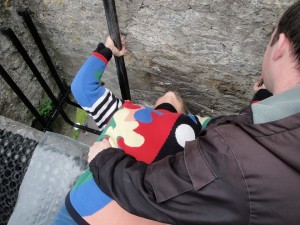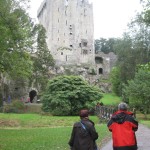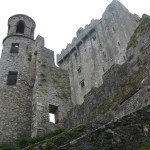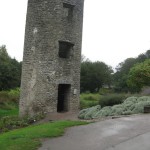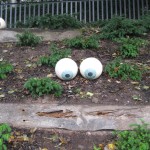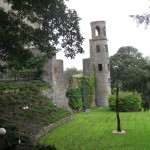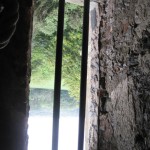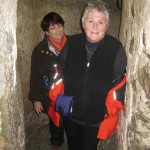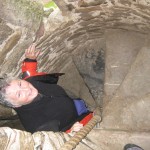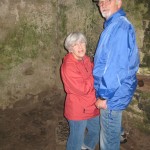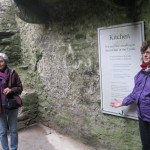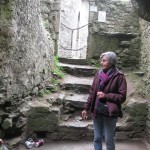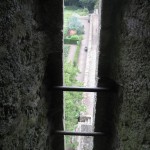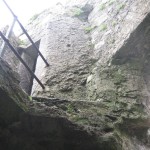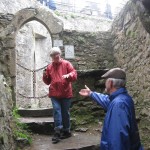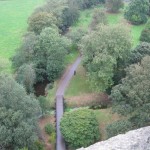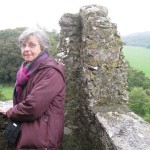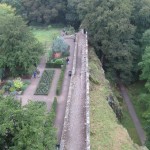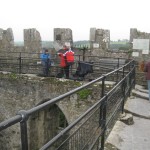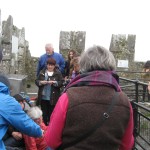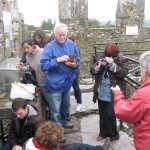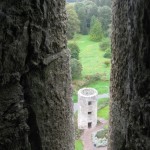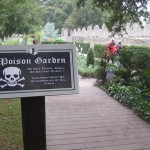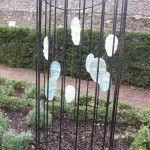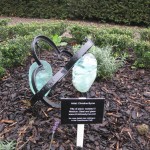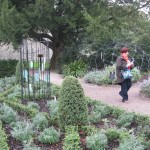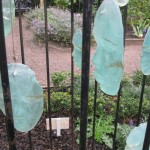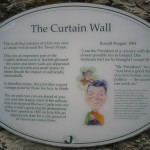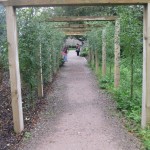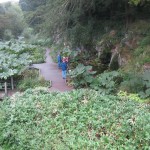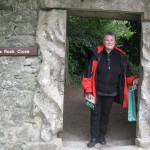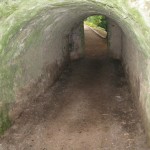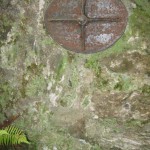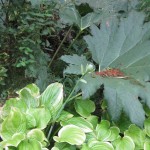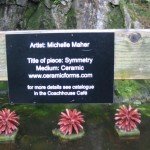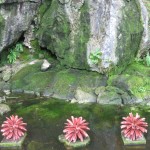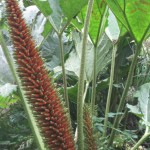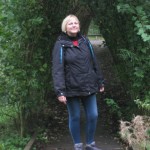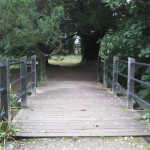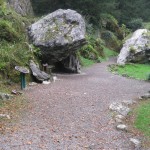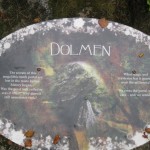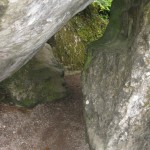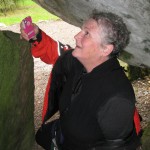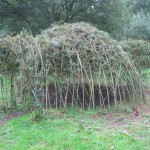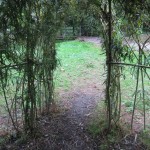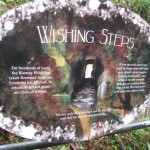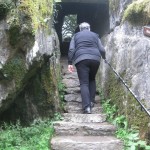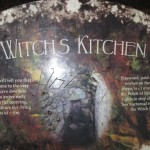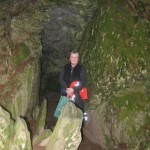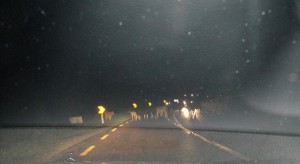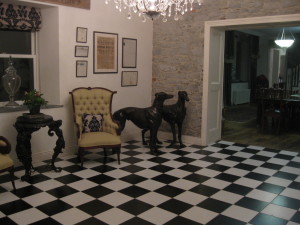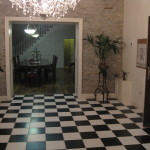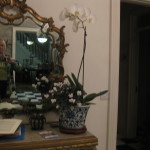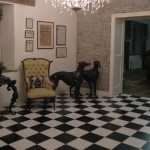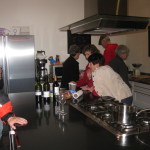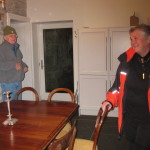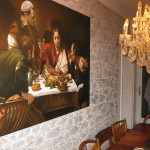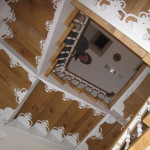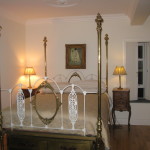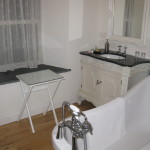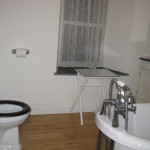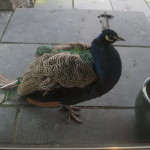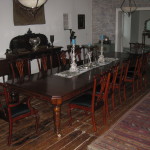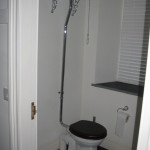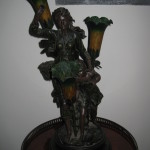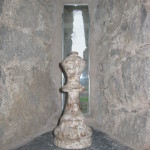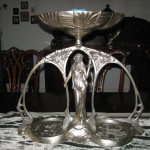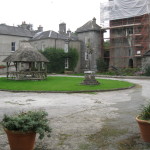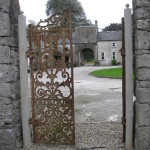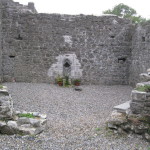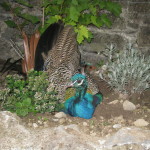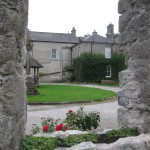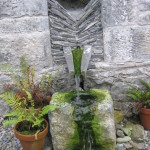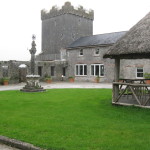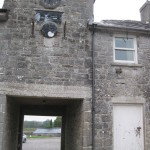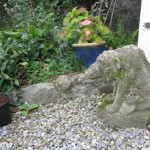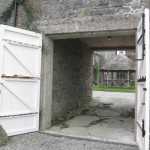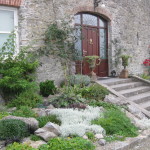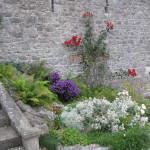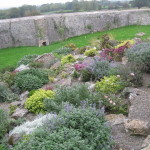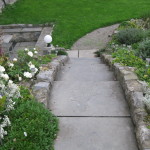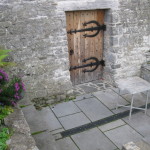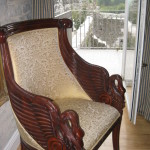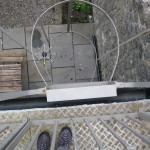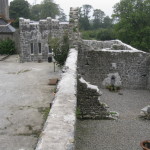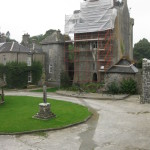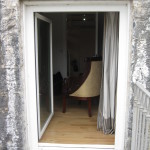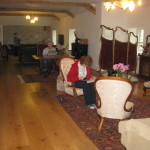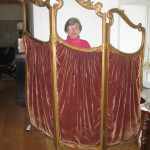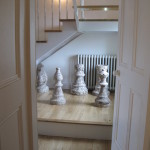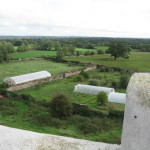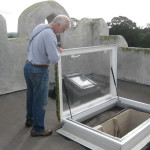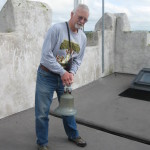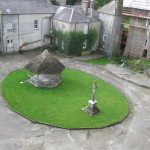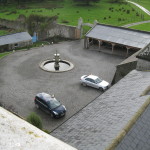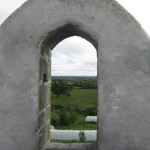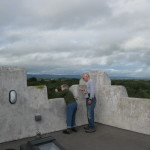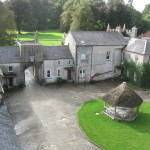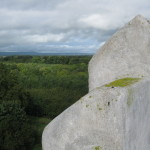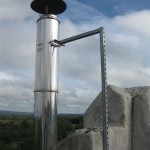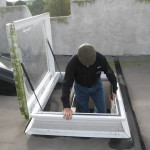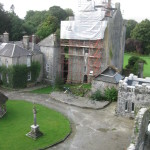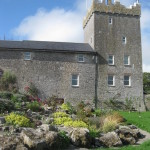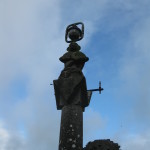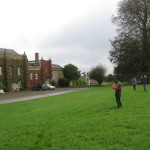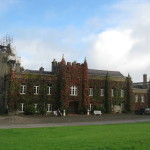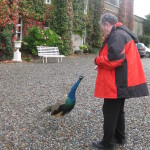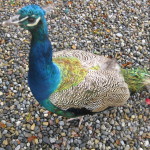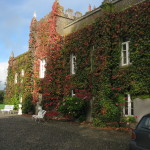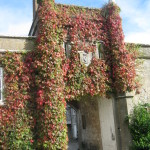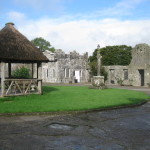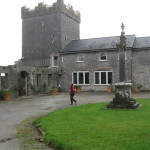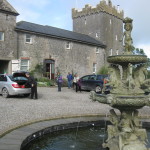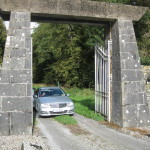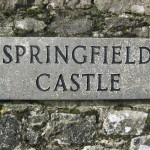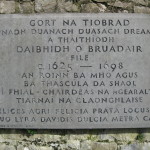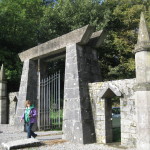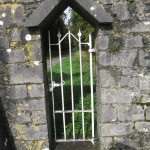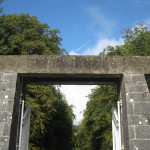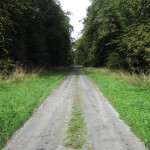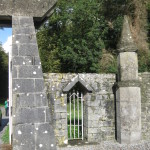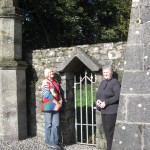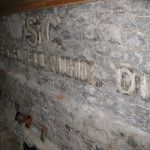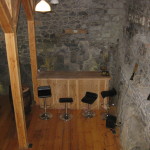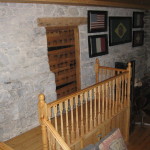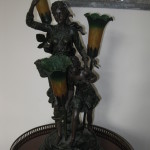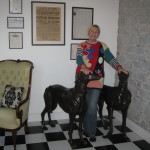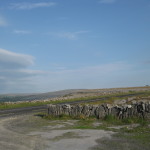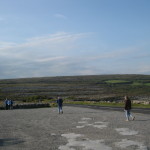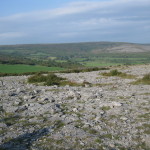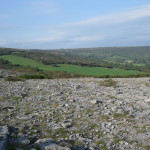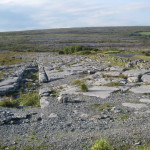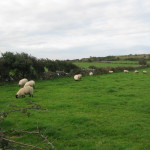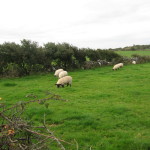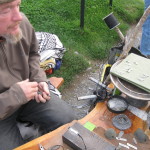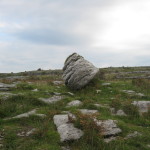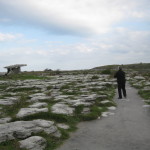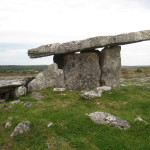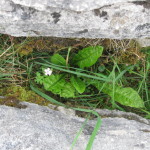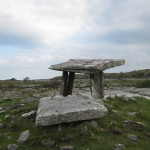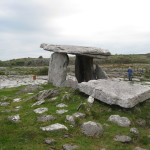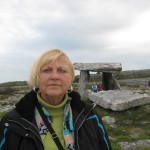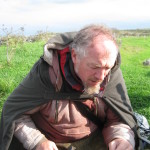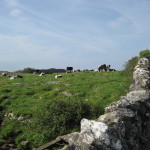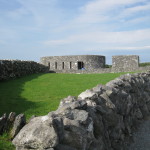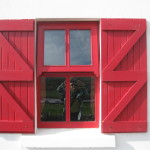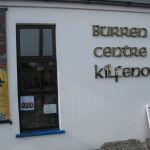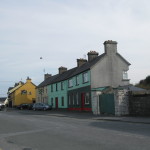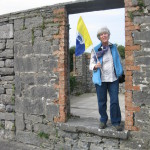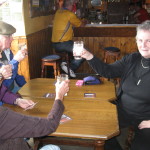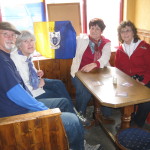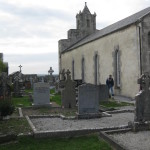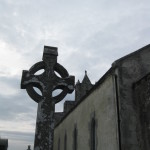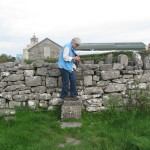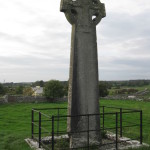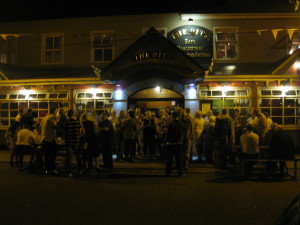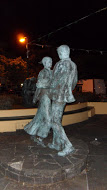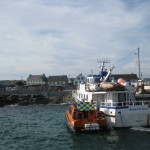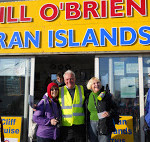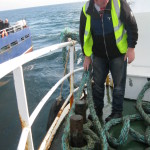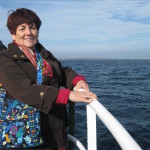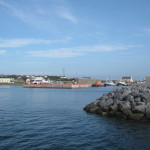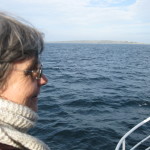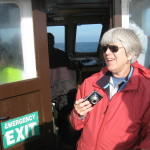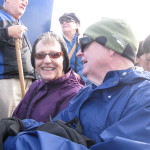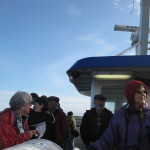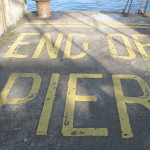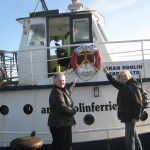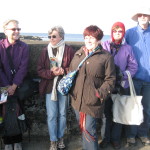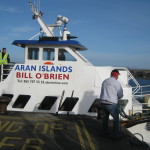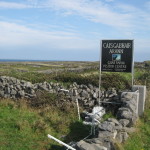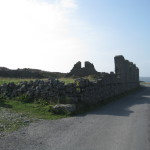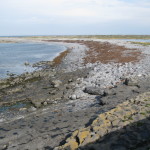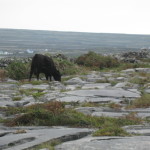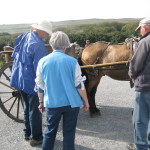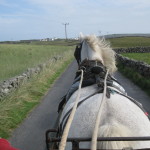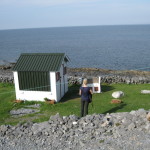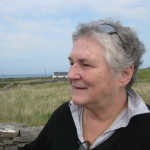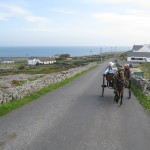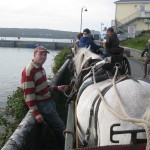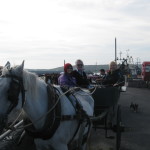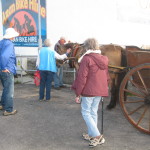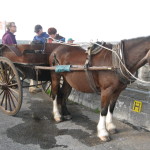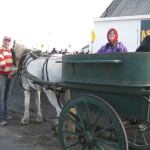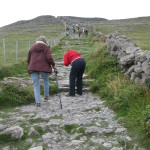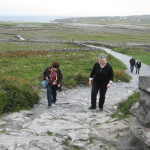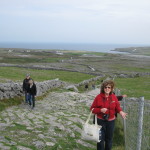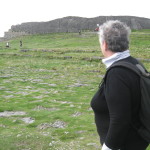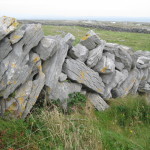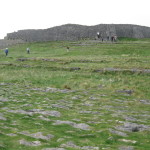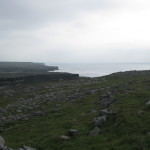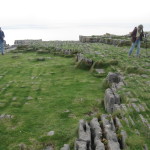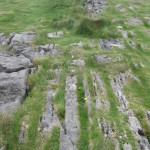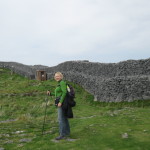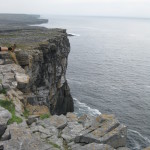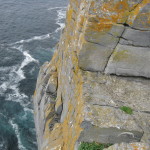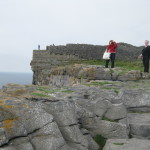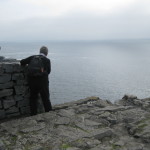It’s a Lot of Blarney!
It was Sunday, September 28, 2013 and our group of regular church-goers was instead, this Sunday, on their way to catch a little of a Leprechaun’s gift of gab at the Blarney Castle by kissing the legendary Stone of Eloquence, found at the top of the Tower. Kiss it and you’ll never again be lost for words, so goes the legend.
The Blarney Castle was started in the tenth century as a wooden structure. Around 1210 A.D. it was replaced by a stone structure, later demolished for foundations. In 1446 the third castle, still standing today, was built by Dermot McCarthy, King of Munster.
For over 200 years, famous people from all over the world, from every occupation, have climbed the steps to kiss the Blarney Stone and gain the gift. At one time visitors had to be held by the ankles and lowered head first over the battlements (defensive architecture). Today, with safety in mind, visitors lean backwards from the parapet walk, holding on to an iron railing and kiss the Stone, still set in the wall below the battlements.
The legend of why we kiss the stone goes back to the McCarthy’s of Muskerry and the McCarthy who was King of Munster, who was said to have supplied four thousand men from Munster to assist the forces of Robert the Bruce of Scotland at the battle of Bannockburn in 1314 against the English. Legend has it that Bruce gave half of the Stone of Scone, the famous coronation stone, to McCarthy in gratitude. This, now known as the Blarney Stone, was incorporated in the battlements.
My favorite story about the stone is the opposite of eloquence and more in line with our saying today, “That’s just a lot of Blarney”. It is said that Queen Elizabeth I commanded the Earl of Leicester to take possession of the Blarney Castle. Whenever he attempted to carry out the command, McCarthy always delayed the attempt and the Earl always delayed the reports to the Queen by making up excuses, maybe telling lies, in fact. The Castle, still not taken, so irritated the Queen that she remarked that the Earl’s reports were all ‘Blarney’.
- The walk to the Blarney
- Main Castle Keep and Tower
- The Tower
- Contemporary sculpture. Eyes?
- Tight fit for all of us to the top.
- The parrapet walk.
- Don’t drop her!
We were nine of the typical millions of tourists, over a few hundred years, to visit the Blarney, a world landmark. As they say, “When in Rome.” We couldn’t pass up an opportunity like that. Our very own Springfield Castle was only a little more than an hour away. While seven of us attempted to become eloquent speakers, two others ventured off to have more time in the gardens built in the eighteenth century during the reign of Queen Anne. Sir James St. John Jefferies built a Georgian gothic house up against the castle, the custom all over Ireland. At the same time, the Jefferies’s family laid out a landscape garden known as the Rock Close with massive boulders and rocks arranged around what seemed to have been druid remains from pre-historic times. Many of the yew trees and evergreen oaks that we saw are extremely ancient.
After climbing to the top of the tower and kissing the Stone while being hung over a drop that seemed twice as high as a football field is long and being held in place by my ankles by a teenager who probably has a secret dream of doing away with all adults, I was ready to stroll in the Rock Close and relax! (I was really held at the waist, but don’t you think that “held by my ankles” makes this story a bit more dramatic?)
The Dolmen was truly magical, as was the Wishing Steps. If you closed your eyes and walked to the top and back to the bottom while you concentrated only on your wish, it would come true. I did it, eyes closed, without falling, concentrating on my wish and it still hasn’t come true. The myth did not say how long it would take to come true, but I am impatient. I want it yesterday!
We drove on to Cork City after our Blarney experience. Cork City was big, hustle, bustle and non-descript to us on that drizzly day. We had had a wonderful time visiting the Blarney Castle and especially the gardens, so we didn’t have a lot of time in the City. I had printed directions for a parking garage and had prepaid before we left the US. Parking anywhere in Ireland is a pain in the behind and expensive. Those particular Google directions were so misleading! We went ‘round and ‘round trying to find the place. I was ready to pull into any garage and forget about the $26, but there were none to be seen. After asking for directions, more than once, we finally found it.
We took the opportunity to walk down the wide snaking St. Patrick’s Street and found a nice place for our late afternoon meal. The place was hopping with sports-minded, Guinness-drinking fans. According to Ireland (the magazine), St. Patrick Street dates back to 1783, but instead of a street, it was a canal of the River Lee. In 1783 it was arched over and for the last 230 years has been Cork’s main commercial center. If it had not been a Sunday and late in the day, we may still be there shopping with the River Lee running deep beneath our footsteps. There were several places I would have liked to have shopped.
The traffic was horrendous. If you’ve been reading my blogs, then you’ll remember that we all got into the sport of Hurling while we were in County Clare. (Read below if you want to learn more about Hurling. It is fascinating!) Now we were in County Cork, the home of the rivals in the big match. And it was this day and this time that the team was heading home. We had the insight to wait until after rush hour to leave the city, but the merchants and shoppers traffic was replaced with sport’s lover’s traffic. We had been around the city enough, earlier, trying to find the parking deck, that we had a better understanding of the layout by this time.
We made our way out of town and on to the road home. It was dark by now and traffic moving toward Cork City was bumper to bumper. We noticed advertisements for a horse show in a village between Cork City and Springfield Castle for that particular Sunday. We saw horse trailers galore in that steady stream of headlight-blinding traffic. It didn’t let up. We kept thinking that the farther we got away from the city, the better the traffic would be. We thought that when we passed the village where the horse show was being held, the traffic would lighten up. It didn’t.
As the traffic thinned a little, we began seeing cars flashing their lights at us, giving us signals to slow down. Low and behold, on one of the few wide highways in this region of Ireland we ran smack into a huge herd of cattle. I thought that one of them was going to walk right up and over the car. They were big cows that stood much taller than the car! I’ve seen the romantic scenes in movies or in advertisements about Ireland when the starry-eyed lovers are stopped in the middle of a country lane by a flock of sheep. But really!!! Cows!!!! And in the dark of night!!! Really!!!!
Hurling:
Hurling, ancient Gaelic and of Irish origin, is played in other countries but Ireland is the only country that has national teams, administered by the Gaelic Athletic Association (GAA). The game has prehistoric origins and has been played for over 3,000 years. It is thought to be the world’s fastest field team game. It is a mix of hockey, lacrosse and baseball with a little football-like scoring thrown in for good measure. One point is scored if you hurl the ball between the crossbars and three points are scored if you hurl it into the net. Go to this YouTube site to see it in action: http://www.youtube.com/watch?v=TmzivRetelE
The 2013 All-Ireland Senior Hurling Championship was the 126th playing of the championship since it was established in 1887. The championship began on May 5 and ended on September 28 when Clare won against Cork.
Ghosts of Springfield Castle
- Our entry way.
- Fresh flowers throughout the castle.
- Impressive bronze dogs.
- Preparing our first snack in the huge kitchen.
- Angela and John admiring the eat-in kitchen.
- Copy of Caravaggio’s “Supper at Emmaus”
- The stairwell in the East Tower.
- Angela and Penny’s bedroom.
- Angela and Penny’s bath.
- Resident peacock we named Elvis.
- Formal dining room.
- Two powder rooms in the entrance.
- Art deco pieces everywhere.
- Art deco on the dining table.
- Courtyard.
- Entrance to courtyard from ruins.
- Fountains gurrgling.
- Elvis nesting.
- Close up of fountain.
- Check out the clock.
- Drive way to the courtyard.
- Front door for the East Tower.
- Herbs and flowers everywhere.
- The conversation pit.
- Interesting chair in our bedroom.
- My escape route.
- Ruins-maybe the poets previous residence?
- Renovations on the other tower.
- From my balcony.
- The gathering place to connect to wifi.
- Art deco screen with Barbara.
- Tower hallway.
- Sunny day from the top of the tower.
- Rob helping others up the small stepladder.
- Ring that bell! Call the servants.
- The front drive way and fountain.
- Harriet & Rob.
- The older part of the castle.
- John joining us up top.
- Workmen arrived almost daily.
- The East Tower.
- The symbol of the monkey.
- Everyone taking pictures from the main front entrance.
- The Castle side.
- Elvis eating out of Angela’s hand.
- Looking back at our tower and dining room.
- The fountain that greeted us.
- The entrance gate to the 200+ acres.
- The long, long driverway.
- Motto:‘nothing is difficult to the strong and faithful‘
- Playroom.
- Door to the conversation pit.
- Love the art deco.
- I’m captivated with the dogs!
Moonscapes and Halloween
- The beginning to the road through the Burren.
- Garst limestone everywhere.
- Sheep near Poulnabrone.
- Druid metal worker.
- An erratic.
- Poulnabrone portal tomb.
- Wildlife in the cracks.
- Poulnabrone Dolmen
Matchmaker, Matchmaker, Give Me a Ceilidh (ka-le)
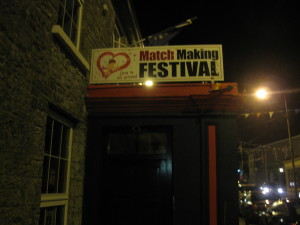 I’ve been working in economic development through arts, culture and tourism in many capacities for more than 10 years now. One theme that comes up over and over and the theme that many of the institutions in SWVA are built around is an Authentic Experience. When we have visitors to the region, are they getting a true and authentic experience? Heartwood, SWVA’s Artisan Gateway has the byline, “Authentic, Distinctive and Alive.”
On one particular evening, Friday, September 27, 2013, on my recent trip to Ireland, my friends and I had that truly authentic experience, and it happened by chance. If I could, I would never plan anything for a trip other than the flight to and from. I would leave all the in-between to chance. Nevertheless, alas, when one is planning for nine people, one needs to have plans.
Our group had a wonderful day visiting the nearby Aran Islands. We returned to the mainland about 5pm and were hungry. Including me, there were three single women on this trip and I had the bright idea of stopping in Lisdoonvarna, only thirty minutes away from the docks at Doolin, to take in the largest Matchmaking Festival in the world.
According to the website http://www.clare.ie/events/view/festivals: “Matchmaking is one of Ireland's oldest traditions and, for the last couple of hundred years, a good deal of it has taken place in Lisdoonvarna during September and early October……… The town developed into a tourist centre as early as the middle of the 18th-century when a top Limerick surgeon discovered the beneficial effects of its mineral waters. People travelled from near and far to bathe in, and drink, the mineral waters.…………It was due to the popularity of these mineral springs and the huge amount of people going there that led to the Lisdoonvarna "matchmaking tradition". September became the peak month of the holiday season and with the harvest safely in, bachelor farmers flocked to Lisdoonvarna in search of a wife. By the 1920s, matchmaking was still in vogue and people continued to come and "take the waters", including many of Ireland's clergy. It was around this time that one of Lisdoonvarna's most famous sayings was coined, describing the town as a place "where parish priests pretend to be sober and bank clerks pretend to be drunk". Today, there is just one official Matchmaker left in County Clare: Mr. Willie Daly who runs the riding centre outside Ennistymon and practices match-making part time. With the exception of the pairings he plans and negotiates, very little genuine matchmaking takes place nowadays. However, Lisdoonvarna's annual festival has evolved into Europe's largest single's event………For the month of September, dances run from noon each day and carry on into the small hours of the next morning………there's live Irish music in most pubs, although getting to the bar can be quite a task………..”
We had dinner in one of the quiet pubs and the married people with me indulged me a walk down the street and time for one dance with one Irishman who was gracious enough to teach me the locals’ steps. I didn’t recognize the steps. It certainly wasn’t Irish Step Dancing. Not quite the same beat at a Texas Two Step; slow, slow, quick, quick. Not really a box step either. It was more of a side step, feet together, other side step, feet together. Anyone who knows me, knows I love to dance. In about a minute that gentleman had me backing up and swinging around and around. I felt like we were Fred Astaire and Ginger Rogers. What fun!!!!!!
Now believe it or not, this is not the authentic experience I am talking about. We gathered the troops and headed back to Ballyvaughan. There was a lot of discussion of one car going and one car staying, but in the end we all headed back. It was only about 9pm and I wasn’t a bit sleepy. My jet lag had long gone. When we drove through town, cars were lined half on and half off the sidewalks. We experienced this park-where-you-like in many of the towns whose streets were so narrow there was no room for parking places. They were lined up outside O’Loclainn’s Whiskey Bar, the place I was so attracted to the day before, the same one with the beautiful window boxes full of purple petunias, the one that wasn’t open when we were touring the town. I still hadn’t had an opportunity to taste the much acclaimed Irish whiskey, and this place was about a two minute walk from our B&B. I didn’t have to drive to get there. It didn’t take much persuading to get five more people talked into walking to that pub for a drink.
As we walked up, there were two guys standing outside and one was doing jumping jacks. I thought it a little odd, but let it go. Angela started in the door and turned quickly and said, “Too crowded, we can’t get in.” I’m not one to let a good time slip by so easily. I said, “Wait a minute, let me look.” I walked in and a couple of friendly people spoke and suggested that I try a table in the back. I did, but the empty table was reserved for an elderly couple who couldn’t stand and who had not arrived at that minute. I squeezed my way back to the front attempting to get back outside to my waiting group. The friendly guys wanted to know why I was leaving and I told them I hadn’t had any luck in finding room at the inn. In true Irish hospitality they said, “Wait.” They talked to some of their friends who were sardined on a wall bench and a few short stools and the next thing I knew, they were getting up and giving my group their seats. They were used to squeezing together to enjoy a pint, so they just lined up two-deep along the bar.
We all ordered our libations. The bartender advised me which whiskey to try. Angela tried a Jameson. The bartender gave me Green Spot, a special in Ireland. I asked my friends at the bar what I should chase it with and they said very as-a-matter-of-factly, “Another whiskey.” So I did. Irish whiskey is distilled three times instead of the usual two as in the US. It was so smooth. I didn’t need a chaser and I didn’t need a mixer. It was delicious.
By this time we’re all feeling good and enjoying the mix of people in the pub. I noticed that Mr. Jumping Jack had reappeared at a table near the door. He stood up and used a spoon to ring his glass for attention. The bar got quiet and he started reciting a wonderful poem. I wish I had a recorder with me. Everyone toasted and another person sang an Irish ballad, Acapella. I realized that Mr. Jumping Jack was the emcee for the evening. All through the night, he quieted the crowd and allowed another participant or himself to sing or recite a poem or tell a story. I found out that many of the people in O’Locliann’s that night were part of a walking club and there was a Walking Festival happening the next day. We landed smack dab in the middle of a ceilidh and didn’t know it. If they hadn’t been so friendly and welcoming, we would have walked out and never had that life-long memory. If you haven’t had a chance to experience a ceilidh, they are described as literary entertainment, stories and tales, poems and ballads, songs, conundrums put, proverbs quoted, and many other literary matters discussed. Many years ago, the Carmichaels of Galax and Lynn McClary (one of my travelers) of Grayson County organized ceilidhs at the 1908 Courthouse in Independence. I hope they can be resurrected.
I would have been happy to stay there to the wee hours listening to their craic (Irish word for fun), a truly authentic experience, and a good time was had by all…….
I’ve been working in economic development through arts, culture and tourism in many capacities for more than 10 years now. One theme that comes up over and over and the theme that many of the institutions in SWVA are built around is an Authentic Experience. When we have visitors to the region, are they getting a true and authentic experience? Heartwood, SWVA’s Artisan Gateway has the byline, “Authentic, Distinctive and Alive.”
On one particular evening, Friday, September 27, 2013, on my recent trip to Ireland, my friends and I had that truly authentic experience, and it happened by chance. If I could, I would never plan anything for a trip other than the flight to and from. I would leave all the in-between to chance. Nevertheless, alas, when one is planning for nine people, one needs to have plans.
Our group had a wonderful day visiting the nearby Aran Islands. We returned to the mainland about 5pm and were hungry. Including me, there were three single women on this trip and I had the bright idea of stopping in Lisdoonvarna, only thirty minutes away from the docks at Doolin, to take in the largest Matchmaking Festival in the world.
According to the website http://www.clare.ie/events/view/festivals: “Matchmaking is one of Ireland's oldest traditions and, for the last couple of hundred years, a good deal of it has taken place in Lisdoonvarna during September and early October……… The town developed into a tourist centre as early as the middle of the 18th-century when a top Limerick surgeon discovered the beneficial effects of its mineral waters. People travelled from near and far to bathe in, and drink, the mineral waters.…………It was due to the popularity of these mineral springs and the huge amount of people going there that led to the Lisdoonvarna "matchmaking tradition". September became the peak month of the holiday season and with the harvest safely in, bachelor farmers flocked to Lisdoonvarna in search of a wife. By the 1920s, matchmaking was still in vogue and people continued to come and "take the waters", including many of Ireland's clergy. It was around this time that one of Lisdoonvarna's most famous sayings was coined, describing the town as a place "where parish priests pretend to be sober and bank clerks pretend to be drunk". Today, there is just one official Matchmaker left in County Clare: Mr. Willie Daly who runs the riding centre outside Ennistymon and practices match-making part time. With the exception of the pairings he plans and negotiates, very little genuine matchmaking takes place nowadays. However, Lisdoonvarna's annual festival has evolved into Europe's largest single's event………For the month of September, dances run from noon each day and carry on into the small hours of the next morning………there's live Irish music in most pubs, although getting to the bar can be quite a task………..”
We had dinner in one of the quiet pubs and the married people with me indulged me a walk down the street and time for one dance with one Irishman who was gracious enough to teach me the locals’ steps. I didn’t recognize the steps. It certainly wasn’t Irish Step Dancing. Not quite the same beat at a Texas Two Step; slow, slow, quick, quick. Not really a box step either. It was more of a side step, feet together, other side step, feet together. Anyone who knows me, knows I love to dance. In about a minute that gentleman had me backing up and swinging around and around. I felt like we were Fred Astaire and Ginger Rogers. What fun!!!!!!
Now believe it or not, this is not the authentic experience I am talking about. We gathered the troops and headed back to Ballyvaughan. There was a lot of discussion of one car going and one car staying, but in the end we all headed back. It was only about 9pm and I wasn’t a bit sleepy. My jet lag had long gone. When we drove through town, cars were lined half on and half off the sidewalks. We experienced this park-where-you-like in many of the towns whose streets were so narrow there was no room for parking places. They were lined up outside O’Loclainn’s Whiskey Bar, the place I was so attracted to the day before, the same one with the beautiful window boxes full of purple petunias, the one that wasn’t open when we were touring the town. I still hadn’t had an opportunity to taste the much acclaimed Irish whiskey, and this place was about a two minute walk from our B&B. I didn’t have to drive to get there. It didn’t take much persuading to get five more people talked into walking to that pub for a drink.
As we walked up, there were two guys standing outside and one was doing jumping jacks. I thought it a little odd, but let it go. Angela started in the door and turned quickly and said, “Too crowded, we can’t get in.” I’m not one to let a good time slip by so easily. I said, “Wait a minute, let me look.” I walked in and a couple of friendly people spoke and suggested that I try a table in the back. I did, but the empty table was reserved for an elderly couple who couldn’t stand and who had not arrived at that minute. I squeezed my way back to the front attempting to get back outside to my waiting group. The friendly guys wanted to know why I was leaving and I told them I hadn’t had any luck in finding room at the inn. In true Irish hospitality they said, “Wait.” They talked to some of their friends who were sardined on a wall bench and a few short stools and the next thing I knew, they were getting up and giving my group their seats. They were used to squeezing together to enjoy a pint, so they just lined up two-deep along the bar.
We all ordered our libations. The bartender advised me which whiskey to try. Angela tried a Jameson. The bartender gave me Green Spot, a special in Ireland. I asked my friends at the bar what I should chase it with and they said very as-a-matter-of-factly, “Another whiskey.” So I did. Irish whiskey is distilled three times instead of the usual two as in the US. It was so smooth. I didn’t need a chaser and I didn’t need a mixer. It was delicious.
By this time we’re all feeling good and enjoying the mix of people in the pub. I noticed that Mr. Jumping Jack had reappeared at a table near the door. He stood up and used a spoon to ring his glass for attention. The bar got quiet and he started reciting a wonderful poem. I wish I had a recorder with me. Everyone toasted and another person sang an Irish ballad, Acapella. I realized that Mr. Jumping Jack was the emcee for the evening. All through the night, he quieted the crowd and allowed another participant or himself to sing or recite a poem or tell a story. I found out that many of the people in O’Locliann’s that night were part of a walking club and there was a Walking Festival happening the next day. We landed smack dab in the middle of a ceilidh and didn’t know it. If they hadn’t been so friendly and welcoming, we would have walked out and never had that life-long memory. If you haven’t had a chance to experience a ceilidh, they are described as literary entertainment, stories and tales, poems and ballads, songs, conundrums put, proverbs quoted, and many other literary matters discussed. Many years ago, the Carmichaels of Galax and Lynn McClary (one of my travelers) of Grayson County organized ceilidhs at the 1908 Courthouse in Independence. I hope they can be resurrected.
I would have been happy to stay there to the wee hours listening to their craic (Irish word for fun), a truly authentic experience, and a good time was had by all…….
Pony Carts and Leprechauns
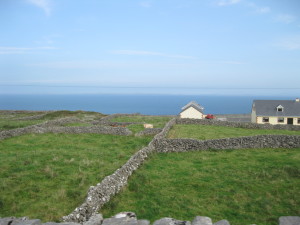 When you think of Ireland, what is the first impression you come up with in your mind? A few might be Leprechauns, Rainbows, Four Leaf Clovers and Green, right?!!??!!
Now that I’ve experienced this “Emerald Isle”, I can better understand why these symbols pop to mind. When I scheduled a trip for late September and early October, I knew we wouldn’t have perfect weather. After doing a lot of pre-trip research, I found that in summer months we might have rain and cooler weather anyway. So why not go on the shoulder season and save a few bucks? We didn’t go a day without sunshine and we didn’t go a day without rain. What’s the old saying? “If you don’t like the weather, just wait a few minutes and it’ll change.” It was easy to see why Ireland is so, so green. Sunshine and rain! Sunshine and rain! What more could the grassy pastures need?
When you think of Ireland, what is the first impression you come up with in your mind? A few might be Leprechauns, Rainbows, Four Leaf Clovers and Green, right?!!??!!
Now that I’ve experienced this “Emerald Isle”, I can better understand why these symbols pop to mind. When I scheduled a trip for late September and early October, I knew we wouldn’t have perfect weather. After doing a lot of pre-trip research, I found that in summer months we might have rain and cooler weather anyway. So why not go on the shoulder season and save a few bucks? We didn’t go a day without sunshine and we didn’t go a day without rain. What’s the old saying? “If you don’t like the weather, just wait a few minutes and it’ll change.” It was easy to see why Ireland is so, so green. Sunshine and rain! Sunshine and rain! What more could the grassy pastures need?
